Gubbins D., Herrero-Bervera E. Encyclopedia of Geomagnetism and Paleomagnetism
Подождите немного. Документ загружается.

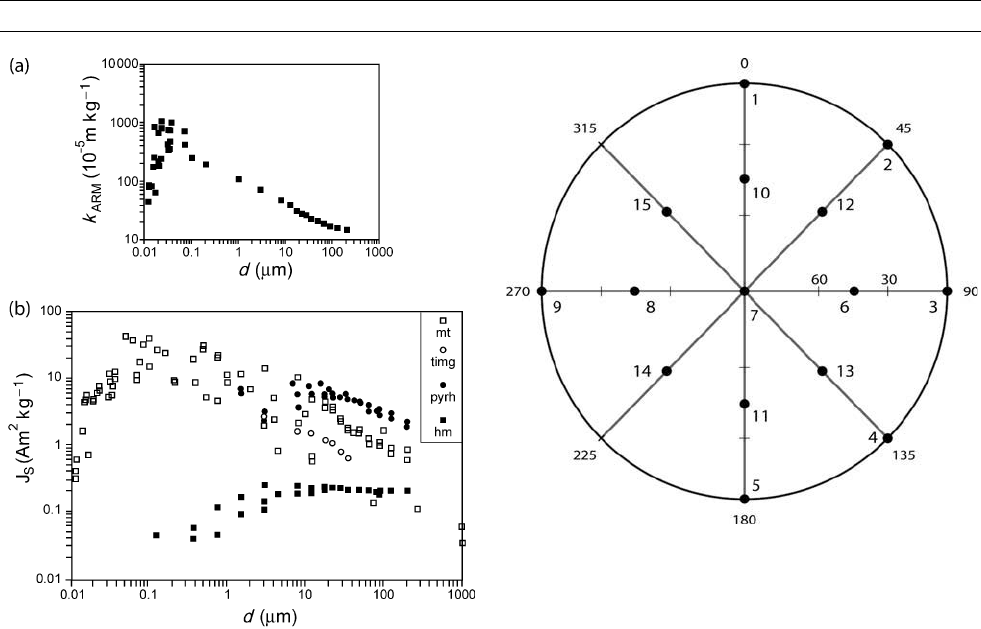
the first-order terms are considered, a symmetric matrix can be
assumed for constant H
IRM
(Cox and Doell, 1967; Stephenson et al.,
1986; Jackson, 1991). Saturation IRM also shows a grain-size depen-
dence for (titano-)magnetite, hematite, and pyrrhotite (Figure M56b).
Measurement of the anisotropy of magnetic remanence
All methods that measure the AMR require a laboratory magnetization
to be imparted along a set of known directions. The most commonly
applied laboratory magnetization is an ARM, although several studies
have used other types of magnetization, such as IRM and TRM. Since
the remanent anisotropy is a symmetric tensor of second rank, at least
six independent measurements must be made to define the tensor.
Many measurement schemes for the AMS have been proposed over
the years (see Borradaile and Henry, 1997), based on early suggestions
of Nye (1957), who suggested 13 positions (Figure M57, excluding
position 5 and 9), and Girdler (1961), who suggested nine positions
(positions 1–4, 6–8, 10, 11). Cox and Doell (1967) first described a
method to measure the anisotropy of IRM (AIRM), using 15 indepen-
dent positions (1–11, with positions 1, 3, 5, and 7 measured twice).
McCabe et al. (1985) proposed using ARM to define the remanent
anisotropy; they used the same positions as used by Girdler (1961)
to measure AMS.
Independent of the type of remanence that is applied and the number
of positions that are used, a general procedure is followed. First a sam-
ple is demagnetized and its remanent magnetization is measured as a
basis for the “demagnetized” or natural remanent state. A laboratory
magnetization is then applied along the first axis, the imparted rema-
nent magnetization is measured, and the component due to the
imparted magnetization is found by vector subtraction of the natural
remanence. The sample is again demagnetized to remove the imparted
magnetization and the demagnetized state is measured as a control.
This procedure is repeated along all the selected field positions, and
the measurements are used to define the matrix k
r
. Differences
between the best-fit ellipsoid and the individual measurements give
the residuals, and these can be minimized by using a least-squares
computation. Jackson (1991) proposed that a goodness-of-fit (GoF)
can be determined from
GoF ¼ RMS=ðk
r1
k
r3
Þ100%
where RMS is the root mean squared residuals normalized to k
mean
.
The expression is an estimate of how well the anisotropy ellipsoid is
resolved. The ellipsoid can be considered well resolved for GoF values
under 10%; typically values are on the order of a few percent.
Stephenson et al . (1986) suggested an alternative method to obtain
the ellipsoid of anisotropy of remanence. They measured the individual
diagonal and off-diagonal matrix elements directly. Here a laboratory
remanent magnetization is applied along the sample x-axis and the
three components of the magnetization are measured. The sample is
demagnetized and the same field is next applied along the sample y-axis
and all the three components of the magnetization are measured.
After demagnetization the field is now applied along the sample
z-axis and the magnetization is measured. This yields nine values
that overdefine the tensor and yield a measure of the precision of
fit. This method is probably reliable for IRM, since the imparted
remanence is relatively large, allowing for accurate determination
of the magnetization components oriented normal to the applied field
direction. It is less reliable for ARM and TRM where imparted
remanences are relatively weak.
Anisotropy of anhysteretic remanent magnetization
(AARM)
The anisotropy of ARM has also been called the anisotropy of anhys-
teretic susceptibility (AAS), since normalizing the magnetization by
the field strength converts it to a pseudosusceptibility. An ARM is
acquired from the DC bias field, often on the order of 0.05–0.1 mT,
superimposed on the AC field. The strength of the bias field is on
Figure M56 (a) Variation in the intensity of anhysteretic remanent
susceptibility (k
a
, intensity of ARM normalized for the applied DC
field) as a function of grain size in magnetite. (b) Variation in
intensity of saturation IRM in different magnetic minerals as a
function of grain size (after Jackson, 1991).
Figure M57 Lower hemisphere, equal area plot that shows
the directions of magnetic field used to investigate the acquisition
of anisotropic remanent magnetization.
536 MAGNETIC REMANENCE, ANISOTROPY
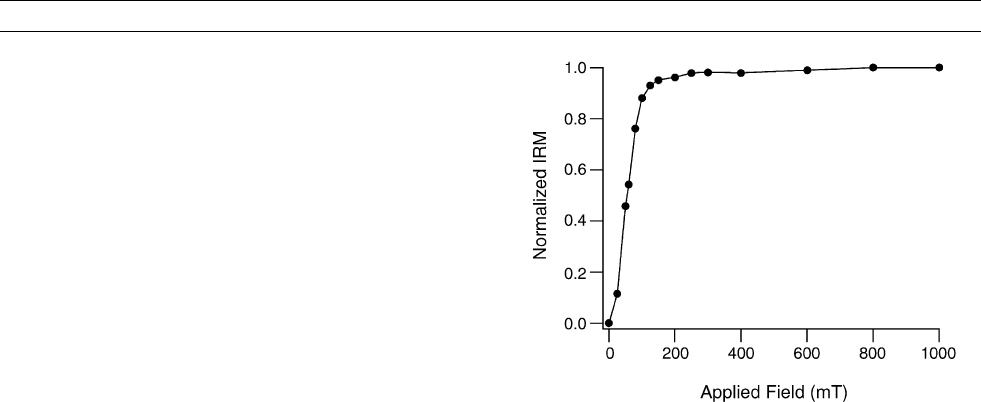
the order of one to two times that of the Earth ’s magnetic field. The
intensity of the AC field can be chosen as desired, but is generally less
than 300 mT, due to limits of commercially available AF demagnetiz-
ing units. This limitation means that an ARM can only be imparted to
minerals with low coercivity, such as (titano-)magnetite or pyrrhotite.
A detailed description of the measurement procedure is outlined above
and has been given in McCabe et al. (1985).
Since the coercivity of ferromagnetic minerals, particularly magne-
tite and titanomagnetite, is dependent on grain size, it is possible to
impart an ARM to a particular grain-size fraction during demagnetiza-
tion in the DC bias field. This is accomplished by switching on the DC
bias field in a specific AC field range or coercivity window during
demagnetization. The imparted magnetization is known as a partial
ARM (pARM). Jackson et al. (1988) demonstrate d that the method
can be used to distinguish if a specific grain-size fraction is responsible
for the observed AARM. For example, a high coercivity window (e.g.,
80– 150 mT) will only magnetize single-domain magnetite, whereas a
low coercivity window (e.g., 0– 30 mT) would magnetize larger multi-
domain grains (see “Geological Applic ations ” sections for a practical
example).
Anisot ropy of isothermal reman ent magnet ization
(AIRM )
The advantage of AIRM is that a relatively strong DC field is applied
to the sample, such that higher coercivity phases may also be magne-
tized. As stated above, IRM is not linearly related to the applie d field;
however, a symmetric matrix can be assumed if only the first-order
terms are considered. Jelinek (1996 ) proposed a nonlinear AIRM
model that more precise ly describes the magnetization phenomena,
in which the anisotropy is also described by a symmetric second-order
tensor. The typical strength of the applied field is between 5 and
60 mT (Tarling and Hrou da, 1993). Cox and Doell (1967), who pro-
posed the method originally, used an applied field of 700 mT, which
is above the saturation of the ferromagnetic phases. The measurement
procedure is the same as outlined above. The main difficulty with their
method is the complete demagnetization between each imparted mag-
netization step. If lower fields are used, it should be possible to demag-
netize with alternating field (AF) demagnetization. Cox and Doell
(1967) rotated their samples in the 700 mT field of an electromagnet
to randomize the magnetization, since complete randomization of mag-
netic domains is reversible.
As with AARM, Cox and Doell (1967) suggested that it is possible
to examine a partial IRM. In their case, they proceeded as follows.
After measuring the sample magnetized in a 700 mT field, the sample
can be subjected to AF demagnetization in a significantly smaller field,
e.g., 100 mT. The remaining magnetization is then remeasured. The
sample can then be further demagnetized in a stronger field, e.g.,
200 mT, and then remeasured. In this manner a set of deviation vectors
is produced,
D ¼ J
r
J
m
H = H
where J
r
is the measured remanent magnetization, which is produced
in the field H, and J
m
is the mean amplitude of a set of J
r
vectors aver-
aged over all the results from the different directions of the applied
field. This gives a set of D (H
0
) for each value of the alternating field
demagnetization (H
0
).
Several cautionary notes should be made concerning the method
and the magnetization process in AIRM. The first cautio n is with
regard to the accuracy with which a field strength can be applied.
A field strength between 5 and 60 mT is in a range where the magne-
tization of a sample is quickly acquired for (titano-)magnetite and iron
sulfides (Figure M58 ). Slight variations in field strength may lead
to apparent anisotropy that is not related to the preferred orientation
of ferromagnetic grains. Figure M58 shows a typical IRM acquisi-
tion curve for a pelagic limestone. In this example a variation in
IRM intensity on the order of 2%, comparable to the required resolu-
tion in the study of AMR, would occur if the field strength varied
by only 2mT.
Caution must also be exercised when measuring the AIRM in pyr-
rhotite-bearing rocks. A study by de Wall and Worm (1993 ) demon-
strated that the shape of the ellipsoid and degree of anisotropy are
dependent on the applied field in rocks containing pyrrhotite.
Although the orientations of the principal axes are not affected, they
showed that the degree of anisotropy in a sample of isometric pyrrho-
tite ore varied between 3.8 and 1.05 for applied field strengths between
1.5 and 100 mT, respectively. The authors attributed this effect to the
control of the observed anisotropy by magnetocrystalline anisotropy in
low applied fields, and by magnetostatic anisotropy, which arises from
the cylindrical sample shape, in strong fields. Jackson and Borradaile
(1991) reported a similar dependence of AIRM and field strength in
hematite-bearing slates, but attributed the effect to different coercivity
fractions in the rocks.
It has been noted by Tauxe et al. (1990) that following repeated
application of an IRM, the coercivity of the specimen increas ed after
exposure to the first high field, so that in spite of demagnetization to
remove the previous magnetization, some grains affected by the first
field application were no longer affected by subsequent field applica-
tions. The authors attributed this effect to hematite grains with meta-
stable domains, which change domain state during the AIRM
experiment.
Ani sotropy of thermal remanen t magnet ization (ATRM)
Heating a sample above the Curie or Néel temperature of its ferromag-
netic phases and cooling it in an applied field will produce a TRM. As
outlined in the general procedure, the sample must be first demagne-
tized. This can be achieved either with AF demagnetization or by heat-
ing the rock above its Curie temperature (T
C
) or Néel temperature
(T
N
), and cooling in zero field. The rock is then magnetized in the first
field direction by reheating above T
C
or T
N
and cooling in a field of
fixed intensity and rate of cooling. It is important that the field intensity
and rate of cooling is the same in all heating runs. After measurement of
the imparted TRM, the sample is again demagnetized. At least six inde-
pendent heating steps are necessary to define the tensor, 12 if the sample
cannot be demagnetized in alternating fields and must be reheated above
the blocking temperature. It is important to control that no chemical
alteration has occurred, which could produce new ferromagnetic miner-
als and affect the acquired TRM. Often a thermomagnetic curve is
made on a small piece of the sample to check that the ferromagnetic
mineralogy is thermally stable.
Figure M58 Example of an IRM acquisition curve for a magnetite-
bearing, pelagic limestone.
MAGNETIC REMANENCE, ANISOTROPY 537
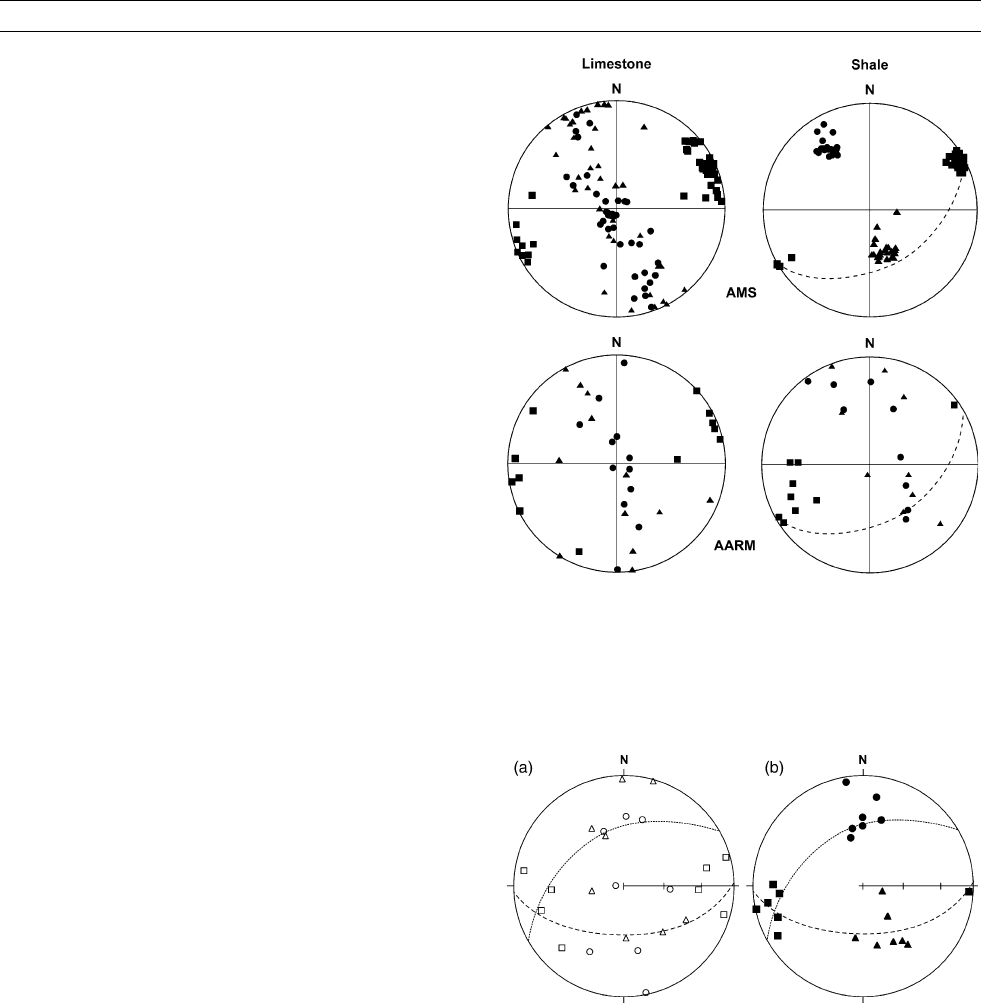
As for a pARM, a partial TRM (pTRM) can be acquired if the field
applied during cooling is turned on only when cooling through a par-
ticular temperature range. This requires accurate monitoring of the
temperature during cooling.
Geological applications
Several examples are presented below to illustrate how AMR can dif-
fer from AMS and the type of geologic information that can be
obtained from remanent fabrics. The most common method used in
examining AMR is AARM. The experimental method is relatively
simple and this magnetization method avoids many problems that have
been found in applying IRM or TRM. The method is suitable for mag-
netite- and possibly pyrrhotite-bearing rocks, but not for high coerciv-
ity phases, such as hematite. In this case, AIRM and ATRM are more
suitable methods. An example is given for AMR in hematite-bearing
rocks. In the examples below, the magnitudes of the principal axes
of the anisotropy ellipsoids are defined as k
1
k
2
k
3
.
AMS and AARM
If the same processes leading to grain orientation affect the ferromag-
netic and paramagnetic minerals in a rock, one would expect that the
magnetic fabric of both components should be similar. The orientation
of the AARM ellipsoid is close to the AMS ellipsoid, and the main dif-
ference between the two fabrics is found in terms of the degree of ani-
sotropy, lineation, and foliation. If the two mineral components formed
at separate times in the history of the rock or if deformation mechan-
isms acting on the different mineral components varied, then it is pos-
sible that the susceptibility and remanence magnetic fabrics could be
different.
The first example illustrates how rock rheology can lead to two dif-
ferent magnetic fabrics. The Lower Paleozoic stratigraphic sequence
from the Central Appalachian Fold and Thrust Belt includes the Lower
Ordovician Coburn limestone, which is overlain by the Reedsville/
Martinsburg shale in central Pennsylvania, USA. Both lithologies
underwent the same deformation during the Alleghenian orogeny.
The AMS was measured with an Agico KLY-2 susceptibility bridge,
and the susceptibility fabric in the limestones can be characterized
by a prolate ellipsoid with k
1
subparallel to pencil structure in the over-
lying shales, which is also the structural trend of the major fold structures,
and k
2
and k
3
distributed in a girdle normal to the k
1
axes (Figure M59).
The prolate fabric is the result of a horizontal tectonic compaction super-
imposed on the vertical bedding compaction. The shales, on the other
hand, have oblate AMS ellipsoids with k
3
subparallel to the pole to bed-
ding and k
1
aligned within the bedding plane, subparallel to the pencil
structure or fold axis. The bedding compaction controls the susceptibility
fabric in the shales.
Magnetite is the major ferromagnetic phase in both lithologies. Ani-
sotropy of ARM was investigated using a 0.1 mT DC bias field with a
150 mT alternating field, and the measurement procedure of McCabe
et al. (1985). The AARM of the limestones is similar to the AMS fab-
ric both in the orientation of the principal axes and the shape of the
ellipsoid (Figure M59). This suggests that the susceptibility and rema-
nent fabrics in the limestone are both controlled by magnetite. The
AARM in the shales, however, is characterized by prolate ellipsoids,
in which k
1
is well-grouped and subparallel to the pencil directions
and k
2
and k
3
are distributed in a girdle in a plane with k
1
as its pole (Fig-
ure M59). This remanent fabric shows that the magnetite grains have
been more strongly affected by the horizontal compaction. The differ-
ence between the AMS and AARM fabrics can be explained by the fact
that paramagnetic clays and phyllosilicates dominate the AMS fabric,
which is largely controlled by bedding compaction. The magnetite
grains acted as rigid particles in a passive matrix during deformation,
and were therefore quicker to respond to the horizontal compression.
In the second example the AARM was determined in the Ordovi-
cian Martinsburg Formation from Lehigh Gap in eastern Pennsylvania
using ARMs applied in two different coercivity ranges. Samples were
taken from the part of the outcrop in which pencil structures are well
developed and a bedding and incipient cleavage can be identified.
Magnetite and pyrrhotite are the main ferromagnetic phases in the
rocks, as determined from IRM acquisition and thermal demagnetiza-
tion of a multiple component IRM. The AARM was first determined
using a 0.035 mT DC bias field with an alternating field of 30 mT,
and then using a 0.1 mT DC bias field with an alternating field of
100 mT, in which the DC bias field was turned on between 60 and
100 mT. The first application would only affect coarser ferromagnetic
grains, whereas the higher coercivity range would selectively magne-
tize finer grain sizes (Figure M56a). Figure M60a shows that the low
Figure M60 Lower hemisphere, equal area plots of the AARM for
(a) low-coercivity range (0.035 mT bias field, 0–30 mT AF), and
(b) high-coercivity range (0.1 mT bias field, 60–100 mT AF). The
bedding plane is shown with the dotted line and the cleavage
plane with the dashed line.
Figure M59 Lower hemisphere, equal area plot showing the
orientation of the principal axes of the AMS (upper plots) and
AARM (lower plots) for the Coburn limestone (left) and Reedsville/
Martinsburg shale (right). The principal axes k
1
are squares, k
2
are
triangles, and k
3
are circles in this and subsequent figures.
Bedding plane in shales is shown with the dashed line.
538 MAGNETIC REMANENCE, ANISOTROPY
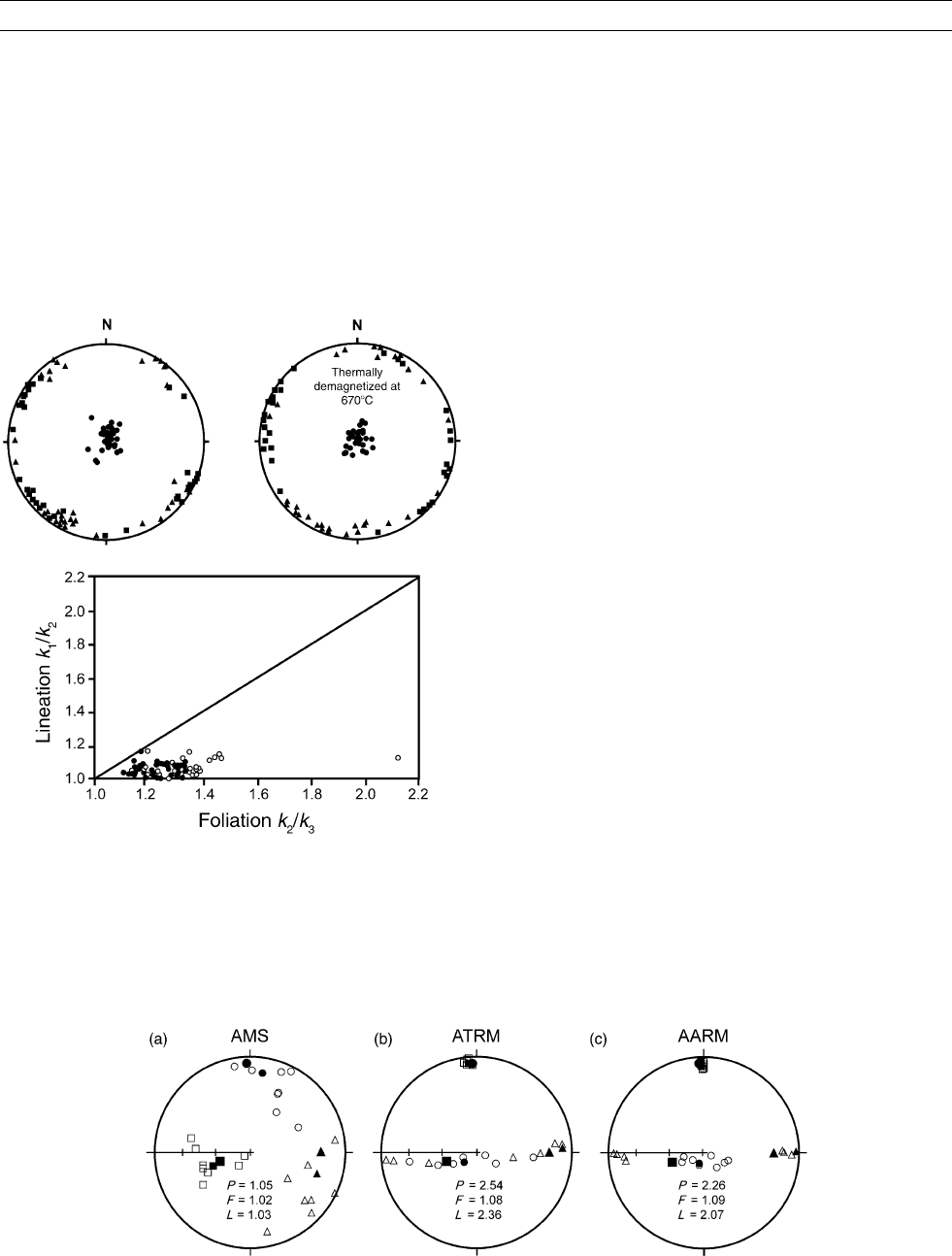
coercivity AARM fabric is not well defined, but the anisotropy is
loosely related to tectonic compaction. This suggests that the coarser
grain were less efficient in orienting in the strain field. The high coer-
civity fabric is well-defined and characterized by a triaxial ellipsoid, in
which the k
3
axes are subparallel to the pole to cleavage, and k
1
axes
mirror the pencil lineation.
AIRM
Tan and Kodama (2002) investigated paleomagnetic directions in the
Mississippian Mauch Chunk Formation in eastern Pennsylvania. They
found that the inclination of the ChRM was shallower than the
expected direction and used AMR to see if the ferromagnetic grains
showed preferential flattening in the bedding plane. Hematite is the
sole ferromagnetic carrier in the red beds, and the ChRM was isolated
in thermal demagnetization above 670
C. IRM acquisition curves
indicate that 85%–90% of the saturation IRM is activated in an applied
field of 1.2 T. The AMS in the rocks has a degree of foliation on the
order of 1.01 to 1.04, which would not result in a significant inclina-
tion flattening. An IRM was applied along nine directions following
the method of McCabe et al. (1985) using a 1.2 T impulse field, and
the tensor solution was found using a method outlined in Tauxe
(2002). Samples were heated to 670
C and cooled in zero field, so that
only the ChRM-bearing hematite retains an IRM. In this manner the mag-
netic fabric due to the grains that are responsible for the ChRM can be iso-
lated. The AIRM shows that the k
3
axes are well-grouped along the pole to
bedding in both the undemagnetized and thermally demagnetized samples
(Figure M61). The k
1
and k
2
axes lie in the bedding plane and are slightly
better grouped in the undemagnetized samples. Both sets of data show the
same degree of lineation, but the demagnetized samples show a slightly
higher degree of foliation (Figure M61). In both AIRM cases the degree
of flattening is almost an order of magnitude higher than in the AMS.
Tan and Kodama (2002) used the AIRM and AMS data to obtain an indi-
vidual particle anisotropy factor, which was then used to correct the paleo-
magnetic inclination. They could show that, after correction, the expected
inclination was in good agreement with a European igneous paleopole of
the same age.
AMS, AARM , and ATRM
Selkin et al. (2000) made a combined study of AMS, ATRM, and
AARM in an anorthositic layer from the Upper Banded Series of the
Precambrian Stillwater complex. The susceptibility fabric, which was
measured with a KLY-2 susceptibility bridge, is compatible with the
preferred orientation of plagioclase crystals in the samples, where k
3
is normal to the foliation plane of the rock and k
1
is close to the c-axis
orientation of plagioclase (Figure M62a). Thermal demagnetization
data indicates that titanium-poor magnetite is the main ferromagnetic
phase in the samples. The AARM was measured in a 0.05 mT DC bias
field and 180 mT alternating field using six different positions. The
ATRM was determined by heating the samples to 600
C and cooling
in a 25 mT field in air; six positions were used to define the tensor.
The two different remanent fabrics are similar, but distinctly different
from the susceptibility fabric (Figure M62b,c). The AARM and ATRM
ellipsoids are prolate with k
1
well-grouped, coinciding with the pole to
the foliation plane defined by the plagioclase crystals and k
3
constrained
in the direction of the plagioclase c-axes. The authors interpret these
results as showing that single-domain magnetite grains are responsible
for the remanent anisotropy. Needles of single-domain magnetite have
been identified by TEM in plagioclase in various intrusions, including
Figure M61 Lower hemisphere, equal area plots of the AIRM for
undemagnetized samples (upper left) and thermally demagnetized
samples (upper right) from red beds of the Mauch Chunk
Formation. Principal axes ratios (lower plot) for the
undemagnetized (solid circles) and demagnetized (open circles)
samples (after Tan and Kodama, 2002).
Figure M62 Lower hemisphere, equal area plot for the magnetic fabric of an anorthosite sample, measured by (a) AMS, (b) ATRM,
and (c) AARM. Large black symbols show the principal axes of the plagioclase fabric, a nd small black symbols are the site mean
averages of the individual sample measurements (open symbols). P is the degree of anisotropy (k
1
/k
3
), L is th e degr ee of lineation
(k
1
/k
2
), and F is the degree of foliation (k
2
/k
3
)(afterSelkinet al., 2000).
MAGNETIC REMANENCE, ANISOTROPY 539

the Stillwater complex, and often the needles are perpendicular to the
plagioclase c-axes. Further support for this interpretation was obtained
from hysteresis loops made along the direction of the principal axes
of the remanence ellipsoids. Single-domain magnetite could also be
responsible for an inverted magnetic fabric in susceptibility anisotropy.
However, the same fabric would be obtained if paramagnetic minerals
are responsible for the AMS. The AMR was used to correct estimates
of paleointensity, which were affected by the preferential alignment of
the magnetite grains.
Ann M. Hirt
Bibliography
Borradaile, G.J., and Henry, B., 1997. Tectonic applications of mag-
netic susceptibility and its anisotropy. Earth-Science Reviews, 42:
49–93.
Cox, A., and Doell, R.R., 1967. Measurement of high-coercivity
magnetic anisotropy. In Collinson, D.W., Creer, K.M., and
Runcorn, S.K. (eds.), Methods in Paleomagnetism. Amsterdam:
Elsevier, pp. 477–482.
de Wall, H., and Worm, H.-U., 1993. Field dependence of magnetic
anisotropy in pyrrhotite: effects of texture and grain shape. Physics
of the Earth and Planetary Interiors, 76: 137–149.
Fuller, M.D., 1960. Anisotropy of susceptibility and the natural rema-
nent magnetization of some Welsh slates. Nature, 186: 790–792.
Girdler, R.W., 1961. The measurement and computation of anisotropy
of magnetic susceptibility of rocks. Geophysical Journal of the
Royal Astronomical Society, 5:34–45.
Graham, J.W., 1954. Magnetic susceptibility anisotropy, an un-
exploited petrofabric element. Bulletin of the Geological Society
of America, 65: 1257–1258.
Hargraves, R.B., 1959. Magnetic anisotropy and remanent magnetiza-
tion in hemo-ilmenite ore deposits at Allard Lake, Quebec. Journal
of Geophysical Research, 64: 1565–1578.
Howell, L.G., Martinez, J.D., and Statham, E.H., 1958. Some observa-
tions on rock magnetism. Geophysics, 23: 285–298.
Jackson, M., 1991. Anisotropy of magnetic remanence: a brief review
of mineralogical sources, physical origins, and geological applica-
tions, and comparison with susceptibility anisotropy. Pure and
Applied Geophysics, 136:1–28.
Jackson, M.J., and Borradaile, G., 1991. On the origin of the magnetic
fabric in purple Cambrian slates of north Wales. Tectonophysics,
194:49–58.
Jackson, M., Gruber, W., Marvin, J., and Banerjee, S.K., 1988. Partial
anhysteretic remanence and its anisotropy: Applications and grain
size-dependence. Geophysical Research Letters, 15: 440–443.
Jelinek, V., 1996. Theory and measurement of the anisotropy of iso-
thermal remanent magnetization of rocks. Travaux Géophysique,
37: 124–
134.
McCabe, C., Jackson, M., and Ellwood, B.B., 1985. Magnetic aniso-
tropy in the Trenton limestone: results of a new technique,
anisotropy of anhysteretic susceptibility. Geophysical Research
Letters, 12: 333–336.
Nye, J.F., 1957. Physical Properties of Crystals. London: Oxford
University Press.
Rochette, P., Jackson, M.J., and Aubourg, C., 1992. Rock magnetism
and the interpretation of anisotropy of magnetic susceptibility.
Reviews of Geophysics, 30: 209–226.
Selkin, P.A., Gee, J.S., Tauxe, L., Meurer, W.P., and Newell, A.J.,
2000. The effect of remanence anisotropy on paleointensity esti-
mates: a case study from the Archean Stillwater Complex. Earth
and Planetary Science Letters, 183: 403–416.
Stacey, F.D., and Banerjee, S.K., 1974. The Physical Principles of Rock
Magnetism. Amsterdam: Elsevier Scientific Publishing Company.
Stephenson, A., Sadikun, S., and Potter, D.K., 1986. A theoretical
and experimental comparison of the anisotropies of magnetic
susceptibility and remanence in rocks and minerals. Geophysical
Journal of the Royal Astronomical Society, 84: 185–200.
Tauxe, L., Constable, C., Stokking, L., and Badgley, C., 1990. Use of
anisotropy to determine the origin of characteristic remanent mag-
netization in the Siwalik red beds of northern Pakistan. Journal of
Geophysical Research—Solid Earth and Planets, 95: 4391–4404.
Tan, X.D., and Kodama, K.P., 2002. Magnetic anisotropy and paleo-
magnetic inclination shallowing in red beds: evidence from the
Mississippian Mauch Chunk Formation, Pennsylvania. Journal of
Geophysical Research—Solid Earth, 107B11):2311, doi: 10.1029/
2001JB001636.
Tarling, D.H., and Hrouda, F., 1993. The Magnetic Anisotropy of
Rocks. London: Chapman & Hall.
Tauxe, L., 2002. Paleomagnetic Principles and Practice. Dordrecht:
Kluwer Academic Press.
Cross-references
Magnetic Susceptibility, Anisotropy
Magnetization, Anhysteretic Remanent (ARM)
Magnetization, Isothermal Remanent (IRM)
Magnetization, Natural Remanent (NRM)
Magnetization, Thermoremanent (TRM)
MAGNETIC SHIELDING
There are numerous uses for magnetic shields in research and consumer
electronics. In geophysical research, magnetic shields are used in
paleomagnetic laboratories to protect samples and improve the perfor-
mance of sample magnetometers. Research shields range in size from
10 cm to 15 m.
The irony in magnetic shielding theory is that a shield actually adds
another magnetic field. This new field is specifically designed to be
equal and opposite to the existing field, resulting in a nullification
of, not a removal of the ambient magnetic fields. This is analogous
to gravitational forces at Lagrangian points, or the balance of centripe-
tal and gravitational forces on orbiting bodies, or noise cancellation by
antiphase headphones.
Materials used
Diverse materials and techniques are used for magnetic shielding. The
choice depends on the kind of fields to be opposed (e.g., AC vs DC)
and the specific application. In general, shielding can be accomplished
by using one of two physical phenomenon, either electrical conductiv-
ity or strong magnetic responses. Electrical conductors carry currents
that produce a magnetic field perpendicular to the current direction.
To generate these currents in a conductive sheet, there must be an ori-
ginal, varying magnetic field. Within the conductor, these currents pro-
duce a new magnetic field in the opposite direction to this exciting
field ( Lenz’s law). By surrounding a site with a good conductor, the
volume will be shielded from varying fields coming from all direc-
tions. The important parameters for efficient shielding by conductors
are: conductivity and thickness of the shielding material, frequency
of the magnetic field, and the completeness of enclosure. Of course,
electrical wires can be powered externally to produce a magnetic field
of almost any configuration, including the nullification case of shield-
ing. This will be considered in detail later.
Materials with strong magnetic properties, usually metals containing
Fe, Ni, or Co, can react to changing magnetic fields by generating an
oppositely directed field (magnetic permeability) or can be tuned to
oppose a steady field (magnetic remanence). Efficient shielding by mag-
netic materials depends on the material, its treatment history, as well
as the ambient field characteristics of frequency, strength, gradient,
and source direction.
540 MAGNETIC SHIELDING

Sources of magnetic fields
The goal of magnetic shielding can be either to nullify ambient mag-
netic fields (external source shielding, described in detail later) or to
nullify local, instrument-generated magnetic fields (internal source
shielding). Many consumer electronics and medical diagnostic instru-
ments generate large local magnetic fields. Here the goal of shielding
is to protect other circuits and conductors within the instruments from
unwanted induced currents, and to allow the normal functioning of
other, nearby electronic equipment. The larger the source field, the
more important shielding becomes. Significant care and expense is
taken to shield the immediate environment from monitors and TVs
(cathode-ray tube types), and nuclear magnetic resonance (NMR)
instruments. Since these internal sources generate rapidly varying
magnetic fields, the shielding material must have either high magnetic
permeability or high conductivity.
External source shielding has the challenge of encountering a differ-
ent magnetic environment (differences in frequency, strength, and
direction) in each location. In theory, the entire range of the electro-
magnetic spectrum could be shielded against, but an equally broad
range of shielding materials would need to be used simultaneously.
Great design simplifications can be realized by restricting the shielding
to a specific frequency or a narrow range of frequencies.
Shielding in paleomagnetic research
Paleomagnetic research uses shields to protect samples during rema-
nence measurements and during demagnetization experiments. In
general, shielding design focuses on the reduction of DC fields (stable
in the time domain). Most laboratory sites have large field gradients
owing to the steel in pipes, ducts, building framework, furniture, and
research equipment. Where space permits, some laboratories have fab-
ricated specific, isolated buildings without steel components, to create
a low-gradient environment. Isolation from varying field sources is
another critical design feature. These sources can be: vehicles (moving
or parked), elevators (especially piston types), steel doors, steel con-
tainers, mass spectrometers, magnetic mineral separators, circuit panel
boxes, and electric-powered mass transit.
Three different shielding techniques are used in paleomagnetic
laboratories: coils, high-permeability magnetic sheets, and remanent
magnetic sheets. Current flow in coils of wire can be adjusted to pro-
duce any magnetic field desired, including a field that matches, but is
in the opposite direction to, a component of the ambient field. Sets of
coils can be configured to control a component of the field over a spe-
cified volume, e.g., a pair of coils, spaced apart a distance equal to
their radius (the Helmholtz arrangement). For a review of other multi-
coil arrangements see Kirschvink (1992). The advantages of coil sys-
tems are: relatively low cost, open arrangement, flexible positioning,
and adjustable field strength (net fields other than zero). Disadvantages
are: small-shielded volume relative to apparatus size (shielded volume
to coil volume about 1:100), the need for a large DC power supply,
continuous cost for electrical power, and difficult access to the
shielded center of a three-component set.
High-permeability magnetic materials are extensively used for
research shielding. Nickel-rich metals are common, along with newly
developed materials such as glass and amorphous metals. Rolled into
cylinders, these shields can be arranged concentrically to provide excel-
lent shielding. Design considerations for these cylindrical shields are:
orientation (optimum direction of cylinder axis is perpendicular to the
field), open or closed ends (open-ended cylinders have higher fields at
least 2 diameters inside), and treatment history (both metallurgical and
magnetic degaussing). Small room-sized shields have been made from
high-permeability sheet material (Patton and Fitch, 1962). There are
hybrid designs for these larger shields that utilize low-cost remanent
materials for the bulk of the shielding. The high-permeability magnetic
materials are used only as an inner shield, taking advantage of their
ability to react to (shield against) weak and variable magnetic fields.
The advantages of high-permeability magnetic materials are: effective
shielding over a wide range of frequency and field strengths, including
DC fields. Disadvantages are: cost, annealing and processing restrictions
on size and shape, and permeability reduction if deformed.
Remanent magnetic materials have been extensively used (since
1980) for large volume, room-sized shields (Scott and Frohlich,
1985). Originally developed for the transformer industry, silicon steel
alloys are used as magnetostatic shields in many paleomagnetic labora-
tories. Magnetostatic or DC shielding incorporates a series of design
simplifications that allow the fabrication of large (15 m) and user-
friendly enclosures (open doorways and windows). Therefore, an
entire paleomagnetic laboratory along with thousands of specimens
can be contained inside a shielded enclosure. Remanent shielding
materials must be magnetically tuned (using anhysteretic remanence)
to generate the balanced opposing (or shielding) field. The advantages
of remanent magnetic materials are: low cost, wide range of size, and
high magnetic field strength. Disadvantages are: postfabrication tuning
(remagnetization) is required, and ineffective shielding against variable
magnetic fields.
One distinguishing feature of shields that use magnetic materials is
the concentric layers of shielding material, referred to as shielding
stages. While the typical two-stage shield provides a sufficient field
reduction for many applications, shields with up to six stages have
been fabricated for specific research applications. Each shielding stage
can only respond to the magnetic field where it is located, so that inter-
ior stage shields respond to much smaller fields than the initial (outer-
most) shield. Therefore, interior shields are less effective in both
absolute strength and percent reduction in residual fields. This is
caused by the reduced magnetic alignment in weaker magnetic fields,
called the Langevin alignment function. This applies to both high-per-
meability materials (permeability is much smaller in lower fields) and
in remanence shields (the smaller biasing field lowers the strength of
anhysteretic remanence). Using a three-stage shield as an example,
we start with the outer stage in the Earth’s field (50000 nT), which
can reduce the interior field by 95% (down to 2500 nT). The middle
stage is in the 2500 nT field, and can reduce the interior field by
90% (down to 250 nT). The inner stage is in the 250 nT field, and
can reduce the interior field by 80% (down to 50 nT). Most shields
are assembled starting with the outer shield, progressively adding
stages to the interior. The residual interior field provided by a magnetic
shield is proportional to both the initial strength of the ambient mag-
netic field, and to the magnitude of pre-existing field gradients.
The spacing between shielding stages is approximately 10% of the
shield diameter. Why so far apart? And why not fill the interval
between the stages with shielding material? Wills (1899) examined
these questions in detail for both the two- and three-stage cases. Coun-
terintuitively, his numerical (2D) models showed that for two-stage
shields the residual field was five times higher if the area between
the shielding stages was solid. Theoretically, this decreased shielding
with increased mass is analogous to the decreased field from a sin-
gle-domain particle as it increases in volume to a multidomain state.
Thick magnetic material will magnetically interact with itself, in a
process of self-cancellation that produces a small external field. Like-
wise, the spacing between stages allows each stage to be magnetically
independent, instead of being linked by dipolar interaction into a lower
energy state. Wide spacing between stages is also an important design
feature when large field gradients are present.
If the goal is to shield against high-frequency fields ( >100 Hz), then
thick electrically conductive sheets are used. Thickness is an advan-
tage in this case, where the conductivity phenomenon of skin-depth
is important. Induced electric currents should be able to flow uninter-
rupted in any direction, thus generating the opposing magnetic field.
With conductive materials, multiple shielding stages are not as useful
as concentrating the material in a single, thick layer. At low frequen-
cies (<100 Hz), the rate of change of the magnetic field will not be
able to generate sufficient current flow to create the opposing magnetic
field. In the case of biological research, the shielding must respond to
a wide range of frequencies, therefore dual material shields are usually
MAGNETIC SHIELDING 541

fabricated. One of the design challenges is that these two materials react
orthogonally. Conductive material react to magnetic fields that arrive per-
pendicular to the sheet, as compared to magnetic material that react to
magnetic fields that arrive parallel to the sheet.
Gary R. Scott
Bibliography
Kirschvink, J.L., 1992. Uniform magnetic fields and double-wrapped
coil systems: improved techniques for the design of bioelectromag-
netic experiments. Bioelectromagnetics, 13: 401–411.
Patton, B.J., and Fitch, J.L., 1962. Design of a room-size magnetic
shield. Journal of Geophysical Research, 67: 1117–1121.
Scott, G.R., and Frohlich, C., 1985. Large-volume magnetically
shielded room, a new design and material. In Kirschvink, J.L.,
Jones, D.S., and Macfadden, B.J. (eds.), Magnetite Biomineraliza-
tion and Magnetoreception in Organisms. New York: Plenum
Press, pp. 197–220.
Wills, A.P., 1899. On the magnetic shielding effect of trilamellar sphe-
rical and cylindrical shells. Physical Review, 9: 193–213.
MAGNETIC SURVEYS, MARINE
Definition
A marine magnetic survey is the measurement of Earth’s magnetic
field intensity or its components (such as vertical component) along
a series of profiles over an area of interest with the objective of mea-
suring the magnetism of the ocean floor. The seafloor is known to
be highly magnetized in a pattern of magnetic stripes that record the
history of Earth’s magnetic field behavior, which in turn, allows mar-
ine scientists to determine the age and history of seafloor spreading in
the ocean basins (see Vine-Matthews-Morley hypothesis). Magnetic
surveys are also used to locate a concentration or absence of magnetic
minerals in the search for economic ore deposits (Sheriff, 1981). Var-
iations in the observed magnetic field from the predicted regional field
are called magnetic anomalies and are attributed to variations in the
distribution of materials having different magnetic polarity, remanent
magnetization, and/or susceptibility. The SI units of measurement for
Earth’s magnetic field intensity are nanoteslas (nT) or in the older
cgs system gammas, where 1 gamma is equal to 1 nT. Earth’s mag-
netic field intensity varies between 30000 and 60000 nT and magnetic
anomalies measured at sea are typically in the range of 1–1000 nT.
History of marine magnetic surveying
Magnetic field measurements have been made at sea since the early
days of marine exploration, although these consisted primarily of
directional measurements for declination and inclination (see History
of geomagnetism, Voyages making geomagnetic measurements,
Halley, Carnegie Institute of Terrestrial Magnetism). One of the first
observations that magnetic fields at sea may be caused by seafloor
geologic sources was made by Cole (1908) who compiled a declina-
tion chart of the western Atlantic Ocean around Bermuda in which
“sources of considerable disturbance” could be discerned. The research
vessel (R/V) Carnegie (see Carnegie research vessel) carried out the
first global marine magnetic surveys for the purpose of mapping
Earth’s magnetic field. During World War II, the rise of submarine
warfare precipitated the development of magnetic airborne detectors
(MAD); a self-orienting fluxgate magnetometer flown by an aircraft
above the ocean to detect submerged submarines (Rumbaugh and
Alldredge, 1949). This development allowed for continuous magnetic
field intensity measurements to be made at sea. After the war, one of
these magnetometers was modified into a towed marine magnetometer
(Heezen et al., 1953) and in 1948 the first shipboard magnetic anom-
aly profile was collected across the Atlantic Ocean from Dakar to
Barbados with R/V Atlantis. The profile crossed the then unknown
Mid-Atlantic Ridge and recorded a strong anomaly over the rift valley
that is now known to be the Brunhes central anomaly that marks the
locus of the active mid-ocean ridge spreading center where new crust
is being created at the seafloor. Strong magnetic lows were also found
over the flanks of the ridge, which are now known to be the reversed
crust of the Matuyama Chron and again part of the seafloor spreading
magnetic stripes (see Vine-Matthews-Morley hypothesis).
In 1954, Arthur Raff at Scripps Institution of Oceanography began
using a fluxgate magnetometer based on the Lamont design. Raff
worked with Russell Varian and Martin Packard to calibrate the
ship-towed magnetometer against their newly developed proton pre-
cession magnetometer that provided an absolute value of Earth’s mag-
netic field intensity (Glen, 1982). Proton precession magnetometers do
not suffer from drift problems or require calibration like the fluxgate
sensors and is the standard tool of today ’s magnetic surveying prac-
tice. These early surveys proved successful and Arthur Raff teamed
up with geophysicist Ronald Mason visiting from Imperial College
in London to tow their magnetometer as part of a large bathymetric
survey off the west coast of North America using the US Coast and
Geodetic Survey (USCGS) ship Pioneer. This survey was published
by Raff and Mason (1961) and became one of the key data sets leading
to the acceptance of the ideas about how the marine magnetic stripe
pattern was recorded by the ocean crust and subsequently preserved
by the seafloor spreading process (Dietz, 1961; Hess, 1962).
Today, modern marine magnetometers have a precision of between
1 and 0.1 nT using proton precession sensors, optically pumped
cesium magnetometers or more recently, the Overhauser nuclear pre-
cession magnetometer (see Observatory instrumentation). While mag-
netometers are still towed behind ships for conventional surveys,
magnetic measurements are also made from a variety of seagoing plat-
forms including deep-diving submersibles (Macdonald et al., 1983),
deep-towed sleds (Macdonald, 1977), remotely operated vehicles (ROVs)
(Johnson et al., 2002), and autonomous underwater vehicles (AUVs)
(Tivey et al., 1997). Airborne magnetic surveys are also an impor-
tant method of surveying particularly over the sediment-dominated con-
tinental shelf areas in the hunt for natural resources of economic value
such as oil and gas. The US Naval Oceanographi c Office also ran an
airborne magnetic survey program called Project MAGNET for many
years with the aim of mapping Earth’s magnetic field intensity on a
global scale (see Project MAGNET).
Methodology, analysis, and processing
Sea surface marine magnetic surveys are typically obtained by towing
a magnetometer sensor behind a ship. The sensor is towed at the end
of a cable with electrical conductors that enable the sensor to be pow-
ered and communicated to from the ship (Figure M63). The sensor is
towed between 3 and 6 ship lengths behind the ship in order to reduce
the magnetic effects of the ship on the measurement. The optimal lat-
eral line spacing for a survey is directly related to the water depth
because this is the filtering distance over which the magnetic field
has propagated. The typical depth of the ocean ranges between 2 and
6 km so that a line spacing of 2 to 10 km is usually sufficient for most
surveys (Figure M64). Magnetic surveying is often done in conjunc-
tion with other geophysical techniques such as swath bathymetric sur-
veying, gravity and seismic profiling, any of which may determine the
ultimate line spacing required. The best approach to magnetic surveying
is to collect profiles perpendicular to the magnetic “grain” or strip-
ing that characterizes the ocean basins.
The first step in processing is the removal of noise spikes that may
have been produced from external sources, such as motors and genera-
tors. At equatorial latitudes it is also usually necessary to remove the
diurnal variation in Earth’s magnetic field due to the combined effects
542 MAGNETIC SURVEYS, MARINE
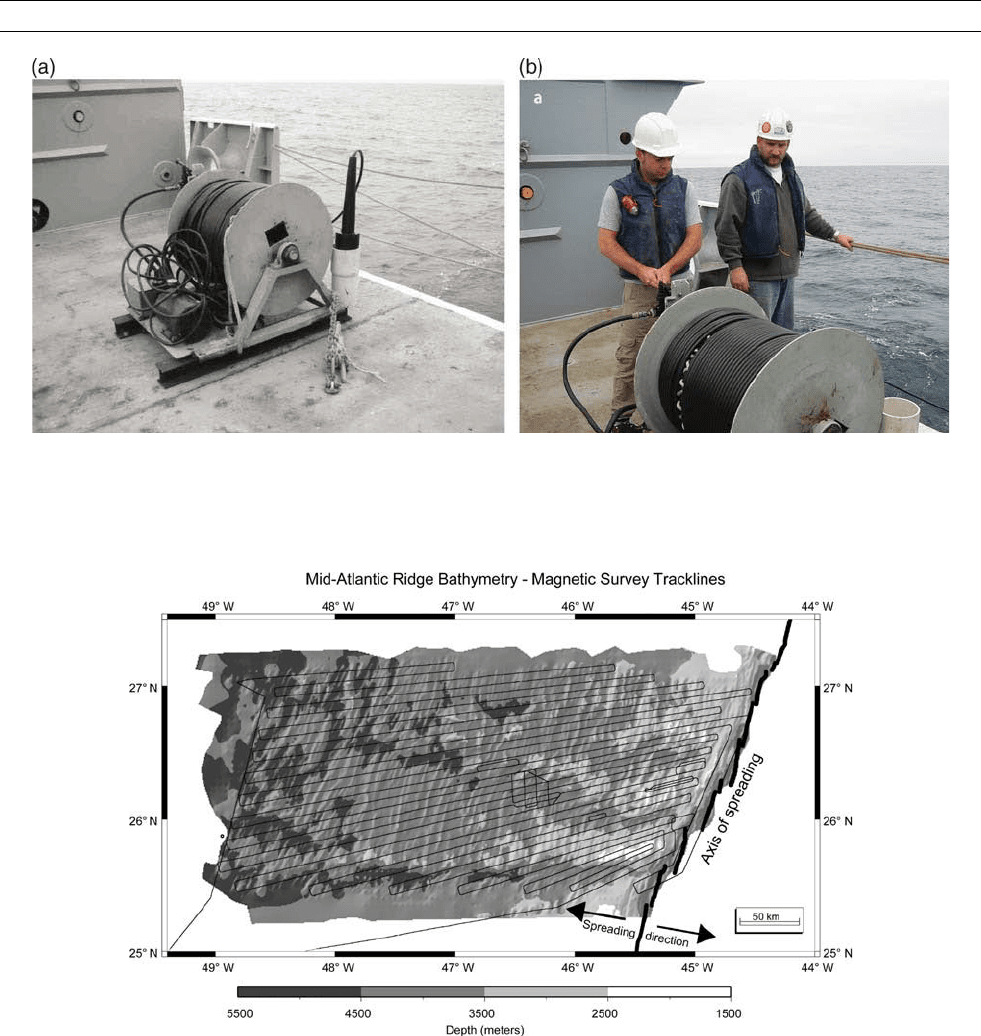
of the equatorial electrojet and the weak equatorial geomagnetic field.
Diurnal records can be obtained from nearby geomagnetic observa-
tories on land or with a temporarily installed base station on the sea-
floor. The next step is to merge the magnetic time series data with
the ship’s position. In the modern era this is easily accomplished with
Global Positioning Satellite (GPS) data, but in the past this was per-
haps the largest source of error, especially in remote areas of the
ocean. Once the position of the magnetic field measurement is known
the regional magnetic field is removed to reveal the residual “magnetic
anomaly” field. Typically, the predicted regional field is obtained from
the global International Geomagnetic Reference Field (see IGRF,
DGRF) spherical harmonic model for the appropriate date and geogra-
phical location of the survey. The suitably processed data can then be
plotted as wiggle plots (Figure M65) or depending on the data density
gridded into a contour map (Figure M66).
Magnetic anomaly highs represent places where the local magnetic
field exceeds the regional field and magnetic lows are where the local
magnetic field is less than the regional field. For marine magnetic sur-
veys these high- and low-magnetic anomalies correspond to magne-
tized zones of normal and reverse polarity ocean crust, respectively.
The source of marine magnetic anomalies is primarily the volcanic
rocks that comprise ocean crust and typically not the overlying
Figure M64 Map showing the seafloor depth for a portion of the western flank of the MidAtlantic Ridge near 26
N. Bold black lines
indicate the location of the midocean ridge spreading axis and arrows indicate direction of seafloor spreading. Data from Tivey and
Tucholke (1998). Thin lines indicate shiptracks.
Figure M63/Plate 9a (a) Photograph showing a marine proton precession magnetometer and tow cable on a winch before launch.
(Photo taken by Maurice Tivey, Woods Hole Oceanographic Institution.) (b) Photograph showing the deployment of a marine proton
precession magnetometer from the stern of a research vessel. (Photo taken by Maurice Tivey, Woods Hole Oceanographic Institution.)
MAGNETIC SURVEYS, MARINE 543
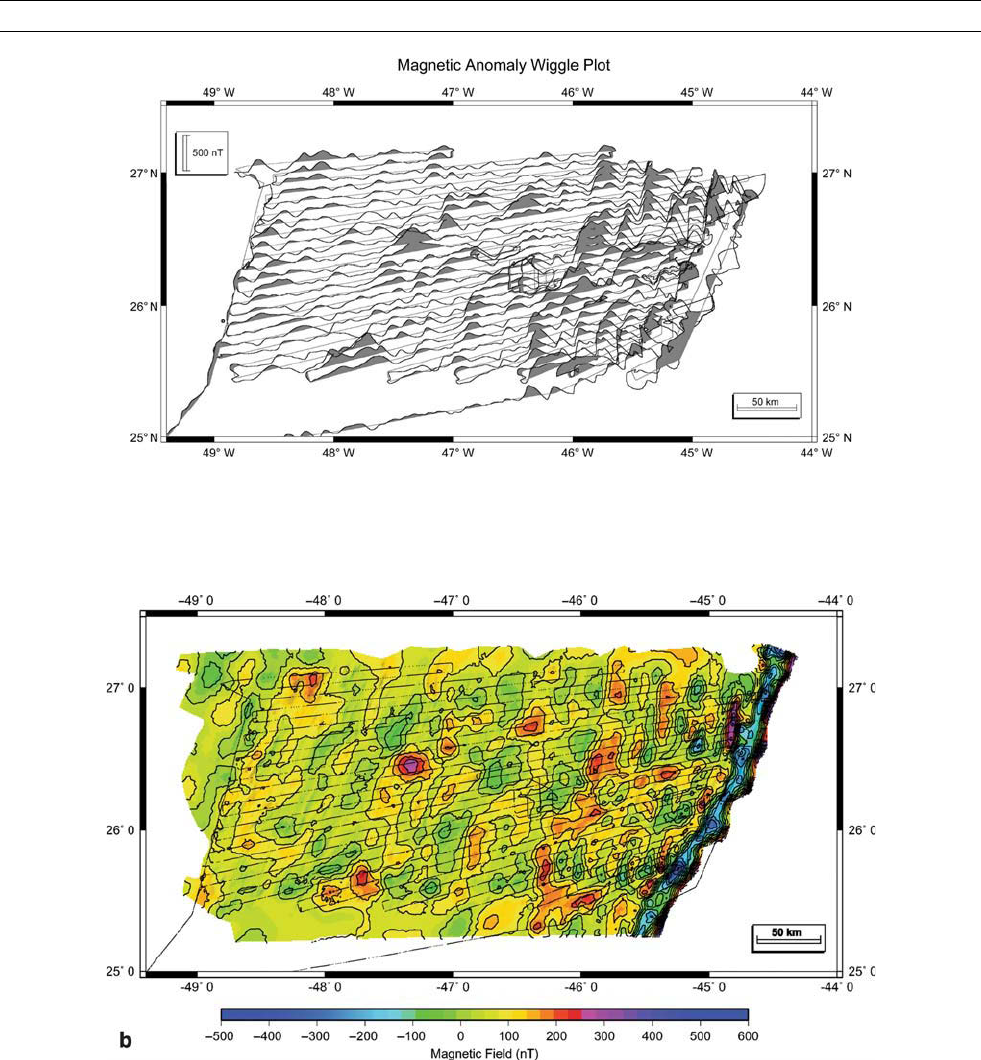
sediments. The magnetic anomalies can be correlated and identified
with the predicted anomalies from the geomagnetic polarity timescale
(GPTS) and thereby allow for an isochron map of the ocean crust to be
generated (Figure M67). This allows for a history of seafloor spreading
to be documented (see Figure M68) and for spreading rates to be cal-
culated.
Magnetic anomalies vary in their morphology according to their
latitude of formation. Magnetic anomalies arise not only from the mag-
nitude of the magnetization but also the direction of the magnetization.
Unlike gravity, which is directed toward Earth’s center, magnetic field
lines originate on south poles and end on north poles. Thus, magnetic
anomalies are centered over the magnetized body at the poles, but off-
set and phase-shifted at midlatitudes with magnetic lows and highs
marking the north and south ends of a normal polarity magnetized
body. At the equator a normal polarized body produces a magnetic
low. These phase shifts can be compensated for by either reducing
the anomaly to the pole (see Reduction to pole) or by computing the
crustal magnetization (Figure M67).
Magnetic surveys are also collected with deep-towed sensors or
other moving platforms such as submersibles or AUVs (see for exam-
ple Tivey et al., 1997, 2003). Such surveys are usually detailed studies
encompassing small areas of the seafloor (<10 km). Additional
Figure M66/Plate 9b Contour map of the same data shown in Figure M65 showing the magnetic anomaly stripes that characterize the
seafloor over most of the ocean basins. Contour interval is 50 nT. Thin black lines indicate the ship’s tracklines. Map based on data
from Tivey and Tucholke (1998).
Figure M65 Map showing the magnetic anomaly wiggles along the tracklines of a marine magnetic survey on the western flank of
the MidAtlantic Ridge near 26
N. Positive anomalies are shaded gray and represent a firstorder normal polarity crust. Negative
anomalies are unshaded and represent the reverse polarity crust. Data from Tivey and Tucholke (1998).
544 MAGNETIC SURVEYS, MARINE
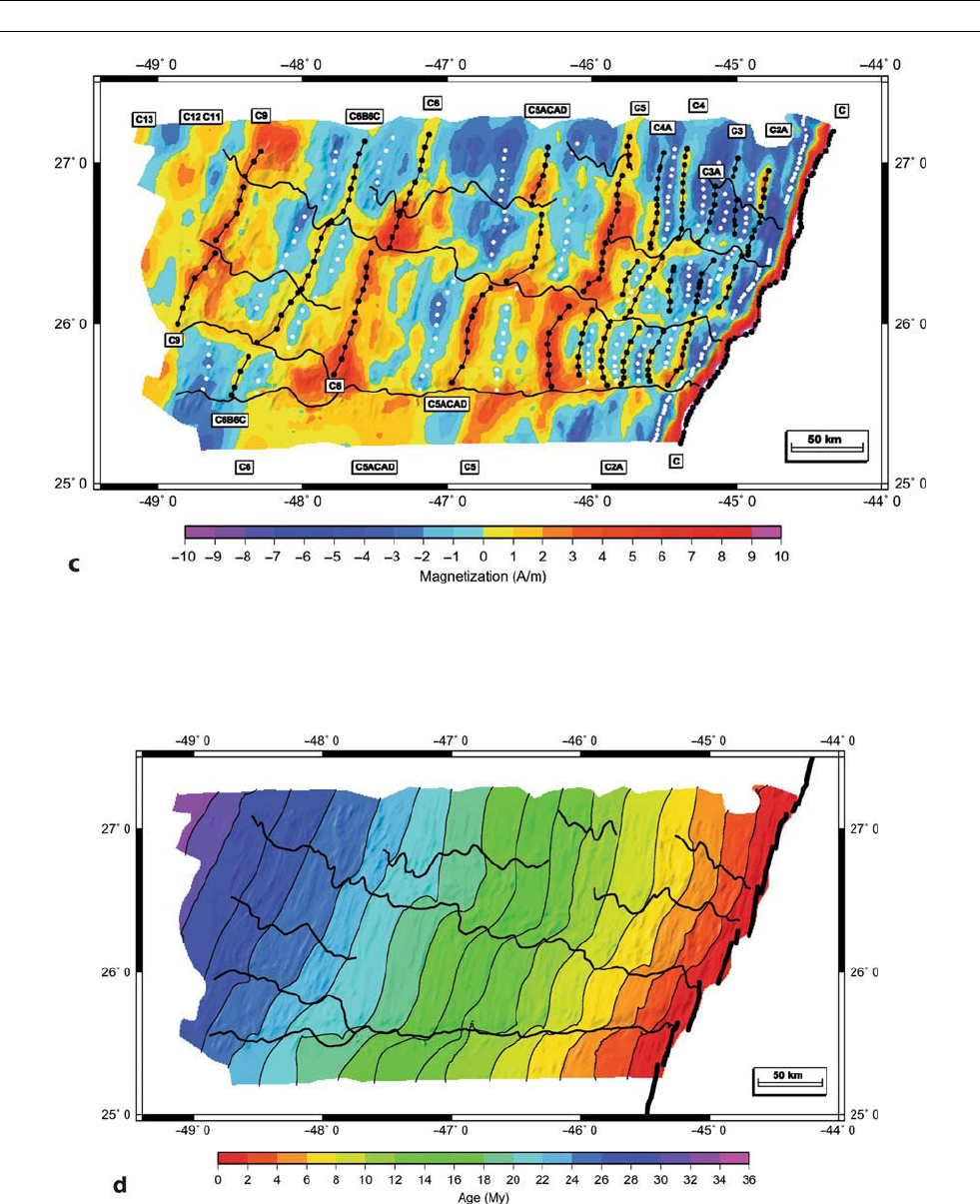
processing steps are required in the analysis of these kinds of data. The
depth and height above the seafloor of the vehicle or platform must
be known with some precision. Various algorithms exist to continue
the data from an uneven observation surface onto a level observation
plane above the topography (see Tivey et al., 2003). If the type of mag-
netic sensor used in the survey is a vector magnetometer rather than
an absolute sensor then the orientation of the vehicle (i.e., its attitude)
must also be known. Finally, navigation requires specialized acoustic
Figure M68/Plate 9d Map showing the interpolated magnetic polarity stripes with normal polarity indicated by black and reverse
polarity in white. Thin black lines indicate the boundaries of individual spreading ridge segments through time. The geomagnetic
polarity timescale is shown at the bottom to correlate with age.
Figure M67/Plate 9c Map of the calculated crustal magnetization based on the seafloor depth (Figure M64) and magnetic anomaly data
(Figure M66). Black dots and adjoining lines indicate the reverse polarity isochrons, whereas the white triangle symbols and adjoining
lines indicate normal polarity chrons. Selected major chrons are identified and can be converted to age using the geomagnetic polarity
timescale shown at the bottom of the figure. Map based on data from Tivey and Tucholke (1998).
MAGNETIC SURVEYS, MARINE 545
